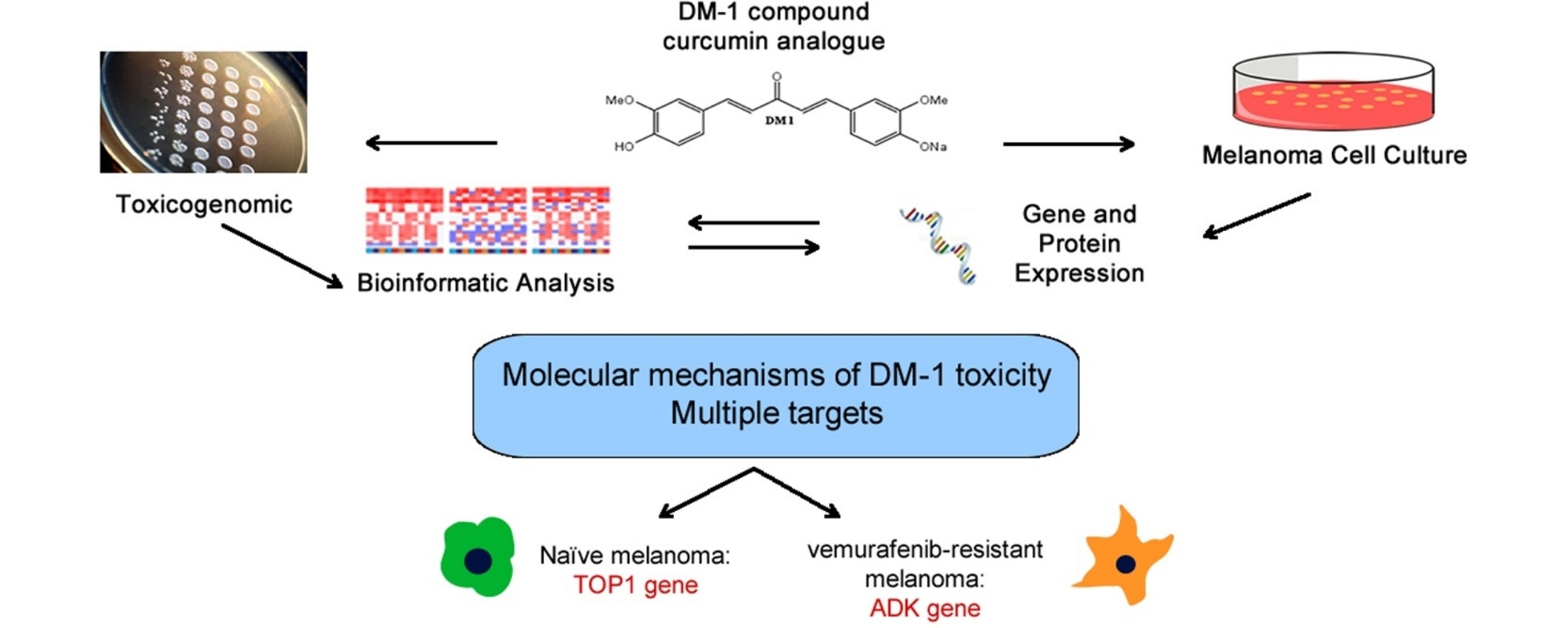Toxicogenomic and bioinformatics platforms to identify key molecular mechanisms of a curcumin-analogue DM-1 toxicity in melanoma cells.
Melanoma is a highly invasive and metastatic cancer with high mortality rates and chemoresistance. Around 50% of melanomas are driven by activating mutations in BRAF that has led to the development of potent anti-BRAF inhibitors. However resistance to anti-BRAF therapy usually develops within a few months and consequently there is a need to identify alternative therapies that will bypass BRAF inhibitor resistance. The curcumin analogue DM-1 (sodium 4-[5-(4-hydroxy-3-methoxy-phenyl)-3-oxo-penta-1,4-dienyl]-2-methoxy-phenolate) has substantial anti-tumor activity in melanoma, but its mechanism of action remains unclear. Here we use a synthetic lethal genetic screen in Saccharomyces cerevisiae to identify 211 genes implicated in sensitivity to DM-1 toxicity. From these 211 genes, 74 had close human orthologues implicated in oxidative phosphorylation, insulin signaling and iron and RNA metabolism. Further analysis identified 7 target genes (ADK, ATP6V0B, PEMT, TOP1, ZFP36, ZFP36L1, ZFP36L2) with differential expression during melanoma progression implicated in regulation of tumor progression, cell differentiation, and epithelial-mesenchymal transition. Of these TOP1 and ADK were regulated by DM-1 in treatment-naïve and vemurafenib-resistant melanoma cells respectively. These data reveal that the anticancer effect of curcumin analogues is likely to be mediated via multiple targets and identify several genes that represent candidates for combinatorial targeting in melanoma.
Authors
Érica Aparecida de Oliveira; Diogenes Saulo de Lima; Lucas Esteves Cardozo; Garcia Ferreira de Souza; Nayane de Souza; Debora Kristina Alves-Fernandes; Fernanda Faião-Flores; José Agustín Pablo Quincoces; Silvia Berlanga de Moraes Barros; Helder I Nakaya; Gisele Monteiro; Silvya Stuchi Maria-Engler
External link
Publication Year
Publication Journal
Associeted Project
Drug repositioning
Lista de serviços
-
As antisense RNA gets intronic.As antisense RNA gets intronic.
-
Androgen responsive intronic non-coding RNAs.Androgen responsive intronic non-coding RNAs.
-
Conserved tissue expression signatures of intronic noncoding RNAs transcribed from human and mouse loci.Conserved tissue expression signatures of intronic noncoding RNAs transcribed from human and mouse loci.
-
The intronic long noncoding RNA ANRASSF1 recruits PRC2 to the RASSF1A promoter, reducing the expression of RASSF1A and increasing cell proliferation.The intronic long noncoding RNA ANRASSF1 recruits PRC2 to the RASSF1A promoter, reducing the expression of RASSF1A and increasing cell proliferation.
-
Antisense intronic non-coding RNA levels correlate to the degree of tumor differentiation in prostate cancer.Antisense intronic non-coding RNA levels correlate to the degree of tumor differentiation in prostate cancer.
-
Insight Into the Long Noncoding RNA and mRNA Coexpression Profile in the Human Blood Transcriptome Upon Leishmania infantum Infection.Insight Into the Long Noncoding RNA and mRNA Coexpression Profile in the Human Blood Transcriptome Upon Leishmania infantum Infection.
-
Long non-coding RNAs associated with infection and vaccine-induced immunityLong non-coding RNAs associated with infection and vaccine-induced immunity
-
Comparative transcriptomic analysis of long noncoding RNAs in Leishmania-infected human macrophagesComparative transcriptomic analysis of long noncoding RNAs in Leishmania-infected human macrophages
-
SARS-CoV-2 Selectively Induces the Expression of Unproductive Splicing Isoforms of Interferon, Class I MHC, and Splicing Machinery Genes.SARS-CoV-2 Selectively Induces the Expression of Unproductive Splicing Isoforms of Interferon, Class I MHC, and Splicing Machinery Genes.

